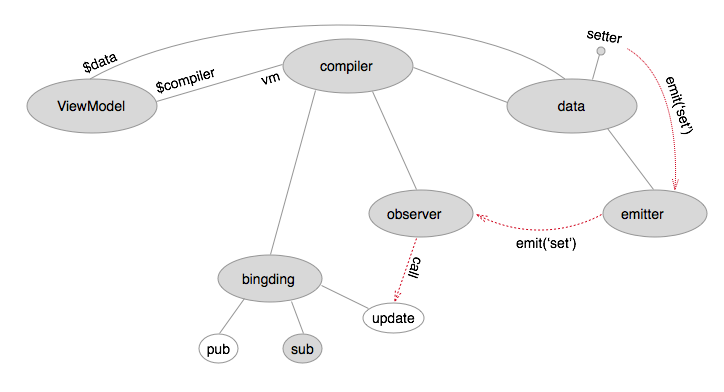VUE 源码分析
简介
Vue 是 MVVM 框架中的新贵,如果我没记错的话作者应该毕业不久,现在在google。vue 如作者自己所说,在api设计上受到了很多来自knockout、angularjs等大牌框架影响,但作者相信 vue 在性能、易用性方面是有优势。同时也自己做了和其它框架的性能对比,在这里。
今天以版本 0.10.4 为准
入口
Vue 的入口也很直白:
var demo = new Vue({ el: '#demo', data: { message: 'Hello Vue.js!' } })
和 ko 、avalon 不同的是,vue 在一开始就必须指定 el 。个人认为这里设计得不是很合理,因为如果一份数据要绑定到两个不同dom节点上,那就不得不指定一个同时包含了这两个dom节点的祖先dom节点。
接下来去找 Vue 的定义。翻开源码,vue 用 grunt。build命令中用了作者自己写的gulp-component来组合代码片段。具体请读者自己看看,这里不仔细说了。
从 /src/main.js 里看到,Vue 的定义就是 ViewModal 的定义。打开 ViewModel,发现它的定义中只是实例化了一个 Compiler,把自己作为参数传给构造函数。同时看到 ViewModel 原型上定义了一些方法,基本上是跟内部事件、dom 操作有关。那接下来我们就主要看看这个 compiler了。不要忘了我们第一个目的是找到它双工绑定的主要原理。
双工绑定
翻到 compiler 的定义,代码太长。犹豫了一下决定还是删掉一些注释贴出来,因为基本上大部分值得看的都在这里,愿深入的读者最好看源文件。
function Compiler (vm, options) {
var compiler = this,
key, i
compiler.init = true
compiler.destroyed = false
options = compiler.options = options || {}
utils.processOptions(options)
extend(compiler, options.compilerOptions)
compiler.repeat = compiler.repeat || false
compiler.expCache = compiler.expCache || {}
var el = compiler.el = compiler.setupElement(options)
utils.log('
new VM instance: ' + el.tagName + '
')
compiler.vm = el.vue_vm = vm
compiler.bindings = utils.hash()
compiler.dirs = []
compiler.deferred = []
compiler.computed = []
compiler.children = []
compiler.emitter = new Emitter(vm)
if (options.methods) {
for (key in options.methods) {
compiler.createBinding(key)
}
}
if (options.computed) {
for (key in options.computed) {
compiler.createBinding(key)
}
}
// VM ---------------------------------------------------------------------
vm.$ = {}
vm.$el = el
vm.$options = options
vm.$compiler = compiler
vm.$event = null
var parentVM = options.parent
if (parentVM) {
compiler.parent = parentVM.$compiler
parentVM.$compiler.children.push(compiler)
vm.$parent = parentVM
}
vm.$root = getRoot(compiler).vm
// DATA -------------------------------------------------------------------
compiler.setupObserver()
var data = compiler.data = options.data || {},
defaultData = options.defaultData
if (defaultData) {
for (key in defaultData) {
if (!hasOwn.call(data, key)) {
data[key] = defaultData[key]
}
}
}
var params = options.paramAttributes
if (params) {
i = params.length
while (i--) {
data[params[i]] = utils.checkNumber(
compiler.eval(
el.getAttribute(params[i])
)
)
}
}
extend(vm, data)
vm.$data = data
compiler.execHook('created')
data = compiler.data = vm.$data
var vmProp
for (key in vm) {
vmProp = vm[key]
if (
key.charAt(0) !== '$' &&
data[key] !== vmProp &&
typeof vmProp !== 'function'
) {
data[key] = vmProp
}
}
compiler.observeData(data)
// COMPILE ----------------------------------------------------------------
if (options.template) {
this.resolveContent()
}
while (i--) {
compiler.bindDirective(compiler.deferred[i])
}
compiler.deferred = null
if (this.computed.length) {
DepsParser.parse(this.computed)
}
compiler.init = false
compiler.execHook('ready')
}
注释就已经写明了 compiler 实例化分为四个阶段,第一阶段是一些基础的设置。两个值得注意的点:一是在 compiler 里面定义一个 vm 属性来保存对传入的 ViewModel 的引用;二是对 method 和 computed 的每一个成员都调用了 createBinding 。跳到 createBinding:
CompilerProto.createBinding = function (key, directive) {
/*省略*/
var compiler = this,
methods = compiler.options.methods,
isExp = directive && directive.isExp,
isFn = (directive && directive.isFn) || (methods && methods[key]),
bindings = compiler.bindings,
computed = compiler.options.computed,
binding = new Binding(compiler, key, isExp, isFn)
if (isExp) {
/*省略*/
} else if (isFn) {
bindings[key] = binding
binding.value = compiler.vm[key] = methods[key]
} else {
bindings[key] = binding
if (binding.root) {
/*省略*/
if (computed && computed[key]) {
// computed property
compiler.defineComputed(key, binding, computed[key])
} else if (key.charAt(0) !== '$') {
/*省略*/
} else {
/*省略*/
}
} else if (computed && computed[utils.baseKey(key)]) {
/*省略*/
} else {
/*省略*/
}
}
return binding
}
它做了两件事情:一是实例化了一个叫做 Bingding 的东西,二是将 method 和 computed 成员的 bingding 进行了一些再处理。凭直觉和之前看过的代码,我们可以大胆猜测这个实例化的 bingding 很可能就是用来保存数据和相应地"更新回调函数"的集合。点进 /src/binding 里。果然,看到其中的 update 、pub 等函数和 sub 、dir 等对象成员,基本证明猜对了。
到这里,实例化的对象已经有点多了。后面还会更多,为了让各位不迷失,请提前看看这张关键对象图:

看完 bingding,我们继续回到 createBinding 中,刚才还说到对 method 和 computed 成员的 bingding 做了一些再处理。对 method,就直接在 vm 上增加了一个同名的引用,我们可以把 vm 看做一个公开的载体,在上面做引用就相当于把自己公开了。对 computed 的成员,使用defineComputed 做的处理是:在vm上定义同名属性,并将 getter/setter 对应到相应computed成员的$get和$set。
至此,compiler 的第一部分做完,基本上把数据的架子都搭好了。我们看到 bingding 的 pub 和 sub, 知道了 vue 也是就与 observe 模式,那接下来就看看它是如何把把视图编译成数据更新函数,并注册到bingding里。
回到compiler里,第二部分处理了一下vm,增加了一些引用。 第三部分关键的来了,一看就知道最重要的就是第一句 compiler.setupObserver() 和最后一句compiler.observeData(data) 。直接看源码的读者,注释里已经很清楚了。第一句是用来注册一些内部事件的。最后一句是用来将数据的成员转化成 getter/setter。并和刚刚提到的bingding 相互绑定。值得注意的是,如果遇到数据成员是对象或者数组,vue 是递归式将它们转化成 getter/setter 的,所以你嵌套多深都没关系,直接替换掉这些成员也没关系,它对新替换的对象重新递归式转化。
这里的代码都很易懂,读者可以自己点进去看。我只想说一点,就是 vue 在内部实现中使用了很多事件派发器,也就是 /src/emitter。比如对数据的 set 操作。在 set 函数只是触发一个 set 事件,后面的视图更新函数什么都是注册这个事件下的。这个小小的设计让关键的几个模块解耦得非常好,能够比较独立地进行测试。同时也为框架本身的扩展提供了很多很多的空间。下面这张图展示了对data的成员进行修改时内部的事件派发:

视图渲染和扩展
看到最后一部分视图渲染,这里值得注意的是,vue 支持的是 angular 风格的可复用的directive。directive 的具体实现和之前的 ko 什么的没太大区别,都是声明 bind、update等函数。
至于扩展方面,vue已有明确的 component 和 plugin 的概念,很好理解,读者看看文档即可。 另外注意下,vue 是到最后才处理 computed 和普通数据的依赖关系的。
总结
总体来说,vue 在内核架构上很精巧。精指的是没有像ko一样先实现一些强大但复杂的数据结构,而是需要什么就实现什么。巧指的是在代码架构上既完整实现了功能,又尽量地解耦,为扩展提供了很大的空间。比如它使用了 binding 这样一个中间体,而不是将试图更新函数直接注册到数据的set函数中等等,这些设计都是值得学习了。 当然我们也看到了一些有异议的地方: 比如是否考虑将数据的转化和视图编译明确分成两个过程?这样容易实现数据的复用,也就是最开始讲的问题。这样改的话,compiler 的实例化的代码也可以稍微更优雅一些:先处理数据和依赖关系,再建立bingding并绑定各种事件,最后处理视图。
这几天有事去了, 没按时更新,抱歉。下一期带来angular源码分析,敬请期待。